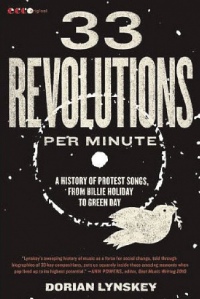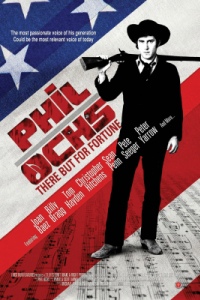
|
33 Revolutions Per Minute
- A History of Protest Songs, From Billie Holiday to Green Day
reviewed by Alan Zisman (c) 2011
First
published in Columbia
Journal September 2011
33
Revolutions Per Minute
- A History of Protest
Songs, From Billie Holiday to Green Day
by Dorian Lynskey
2011, Ecco Publisher
ISBN-13: 978-0061670152
688 pages, $19.99
 There’s a pop-culture myth about protest songs - perhaps
related to the myth that all the pop-culture that matters rose and fell
with the baby boomer generation. In that mythologized story, protest
songs started with Woody Guthrie, continued with Pete Seeger and the
Weavers, were driven underground by McCarthyism, re-emerged in
Greenwich Village with Bob Dylan, Joan Baez, and the rest, were sung at
civil rights and anti-Vietnam War rallies, and then faded away along
with the counter-culture and protest movements in general. There’s a pop-culture myth about protest songs - perhaps
related to the myth that all the pop-culture that matters rose and fell
with the baby boomer generation. In that mythologized story, protest
songs started with Woody Guthrie, continued with Pete Seeger and the
Weavers, were driven underground by McCarthyism, re-emerged in
Greenwich Village with Bob Dylan, Joan Baez, and the rest, were sung at
civil rights and anti-Vietnam War rallies, and then faded away along
with the counter-culture and protest movements in general.
Dorian Lynskey is a music reviewer for the UK’s Guardian newspaper. As
the title of 33 Revolutions Per Minute - A History of Protest Songs,
From Billie Holiday to Green Day suggests, he’s written a history of
protest songs, structured as 33 chapters, one for each of 33 songs.
Also, as the subtitle points out, he extends the canon of protest songs
beyond the Dylan/Baez genre; while including chapters on Woody Guthrie
and his descend introduced Abel Meeropol’s ‘Strange Fruit’ to the
audience of New York’s Café Society.
Lynskey recognizes that there were protest songs prior to ‘Strange
Fruit’ – and even includes a two-page appendix on protest songs prior
to 1900. However, he suggests that earlier protest songs were outside
the pop song mainstream - “They were designed for specific audiences —
picket lines, folk schools, party meetings.”
Protest songs, however, even the 33 songs that Lynskey selects as key,
often fit at best uneasily within the limitations of pop music. Some of
his songs made it onto the ‘charts’ – Stevie Wonder’s ‘Living for the
City’ or Frankie Goes to Hollywood’s ‘Two Tribes’, for example. Others
– ‘We Shall Overcome’, for instance – had a life of their own, becoming
widely known independent of pop music marketing.
Lynskey understands the problems that can occur when songs with a
message are performed in a pop music context – the irony of the
popularity as a right-wing anthem of Bruce Springsteen’s ‘Born in the
USA’ is commented on.
Some of the artists getting a chapter, such as the Dead Kennedys
(represented by ‘Holiday in Cambodia’) or the British band Crass (with
‘How Does It Feel’) would probably like to think of themselves as
anti-pop.
While each chapter refers to a particular artist and song, Lynskey does
a good job of building context – giving both the story of the band or
singer, of the writing or recording of the song, and the broader
political and cultural context. He often goes into detail about other
artists, as well.
So, while Phil Ochs doesn’t get a chapter of his own, he plays a role
in the chapters on Dylan (‘Masters of War’), Country Joe and the Fish
(‘I Feel Like I’m Fixin’ to Die Rag’) and Victor Jara (‘Manifesto’).
He also does a good job with music post-1975; punk and reggae (of
course), but even noting the rebellious streak in the much-maligned
disco, with a chapter subtitled ‘Gay Pride and the Hidden Politics of
Disco’. He notes the role that songs like the Special-AKA’s ‘Free
Nelson Mandela’ played in the anti-apartheid movement, and with seven
chapters dated from 1989 to 2008 helps show that even during this
period, there were undercurrents of protest, with music ranging from
Public Enemy to Rage Against the Machine, to Steve Earle.
He does a less good job in some other areas, though. Inevitably, the
book is (nearly) limited to the Anglo-American music scene, though
three international chapters are included on Chile’s Victor Jara,
Nigeria’s Fela Kuti, and Jamaica’s Max Romeo. As with the other
chapters, they go beyond the single musicians and songs.
Women are nearly invisible, however. Yes, the book opens with Billie
Holiday. After that, we get Nina Simone (with ‘Mississippi Goddam’).
Then no one until 1993’s Riot Grrrl movement, represented by Huggy
Bear’s ‘Her Jazz’. The Dixie Chicks get mentioned in the context of
Natalie Maines’ 2003 comments about George Bush, but they’re just an
aside in a chapter based around Steve Earle’s ‘John Walker’s Blues’
(subtitled ‘Saying the Unsayable After 9/11’).
(I suppose Lynskey would consider the music of self-identified
feminists like Holly Near as ‘designed for special audiences’).
In an epilogue, Lynskey notes that the best-selling song in the UK over
Christmas 2009 was Rage Against the Machine’s angry ‘Killing in the
Name’. But he points out that this happened as the result of a
grassroots movement to prevent the winner of TV show ‘The X-Factor’
from being the Christmas top of the pops. “The state of political
music”, he suggests: “a protest song can only succeed on a grand scale
if it’s turned into a joke”.
He is pessimistic about the future of protest songs: “The failure of
protest songs to catch light during the Bush years leaves one wondering
what it would take to spark a genuine resurgence”. He suggests that
this is a reflection in a broader “loss of faith in ideology and a
fading belief in what we might call heroes”.
(Or as if what Bob Dylan famously suggested (in a more innocent age) –
‘Don’t follow leaders, watch the parking meters’ has come to pass).
In the end, Lynskey tells us: “To create a successful protest song in
the 21st century is a daunting challenge, but the alternative, for any
musician with strong political convictions, is paralysis and gloom…. To
take on politics in music is always a leap of faith…. It falls to
musicians to continue to make those attempts; whether they succeed or
note depends on the rest of us”.
 Phil Ochs: There But for Fortune Phil Ochs: There But for Fortune
written and directed by Kenneth Bowser
released by First Run Features
2011, 98 minutes long
Phil Ochs didn’t rate a chapter in Dorian Lynskey’s 33 Revolutions Per
Minute – his 1967 album ‘Pleasures of the Harbor’ made it to #168 on
the Billboard charts. he is the subject of the 2011 documentary: Phil
Ochs: There But For Fortune, which was screened in August by the
Pacific Cinematheque.
Written and directed by Kenneth Bowser, the 98 minute film looks at the
life, music, and times of Ochs, with numerous interviews with
contemporaries from Joan Baez to Tom Hayden, family members including
Ochs’ brother, sister, wife, and daughter, as well as people influenced
by his music, such as Billy Bragg and Sean Penn. Bob Dylan (who does
get a chapter in Lynskey’s book) apparently refused to be interviewed.
(Apparently, Ochs often felt like he was competing with Dylan; Dylan
never compared himself to Ochs).
News clips are effectively used to place Ochs and his music in the
context of the civil rights and anti-war movements of the 1960s.
While Ochs tried to move his music beyond the “All the News That’s Fit
to Sing” topical songs of his early albums, he is most remembered for
his series of protest songs from the early to mid 60s, reflecting his
sense that the US was failing to live up to promises of justice and
equality.
The documentary shows how Ochs, with a family history of
manic-depression and a tendency towards alcoholism, was unable to move
beyond the movements of the 1960s. As the anti-war movement wound down,
his 1970s centered around the 1973 coup in Chile (and the murder of
Chilean political singer Victor Jara), a trip to African – where his
little-heard recordings with African musicians pre-figured similar
recordings by Peter Gabriel and Paul Simon – that resulted in a mugging
that damaged his vocal chords, and finally the end to the Vietnam War.
Less than a year after the fall of Saigon, Phil Ochs hung himself in
his sister’s house. He was 35.
|

